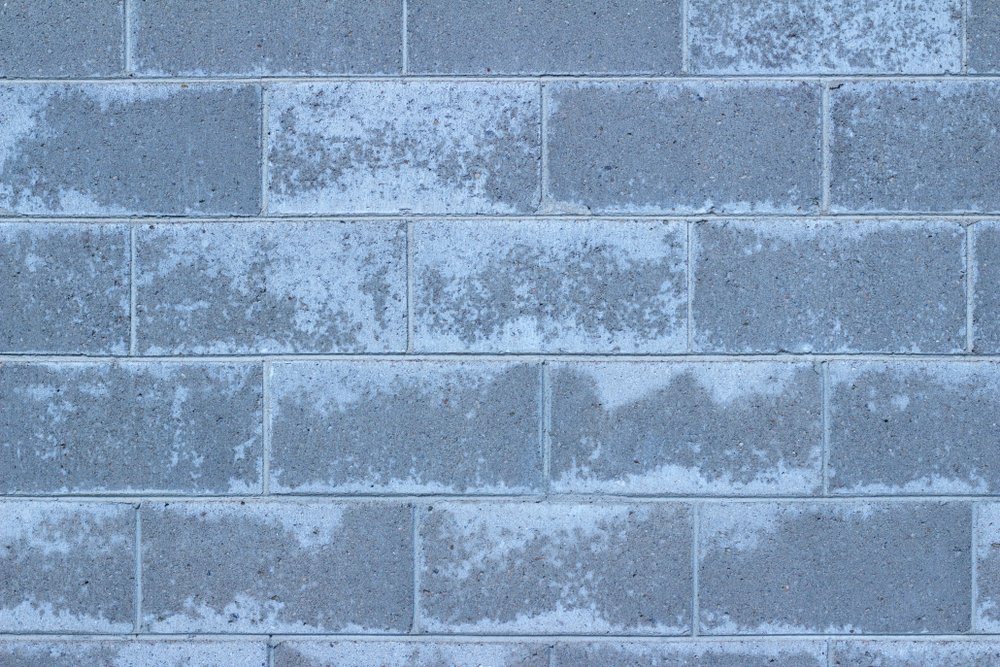Have you ever seen chalky, white, and powdery residue on your concrete basement walls? This is known as efflorescence, and while it is generally harmless on its own, it can often indicate growing concerns that you shouldn’t ignore.
In this post, we’re going to cover what efflorescence is, what its appearance on your basement walls means, how you can remedy it, and when you should contact a professional.
What is Efflorescence?
Efflorescence is a white or grayish buildup of salts that occurs when water is present on mineral-origin building surfaces like concrete, brick, stone, etc. When water on these surfaces evaporates, the efflorescence remains.
Efflorescence Causes
Efflorescence is most commonly caused by water soaking into your wall or floor and then evaporating. This can include natural water sources like rain, snow, and groundwater seeping in or by pipe leaks in a building.
However, water alone does not cause efflorescence. For it to occur, certain other conditions must be present. First, water-soluble salts must be present on the surface. After this, the moisture brings the residue to the surface and then evaporates. The crystallized remains of this phenomenon are the efflorescent stains on the wall, floor, or ceiling.
Poor moisture prevention can also contribute to efflorescence. As an example, improperly vented crawlspaces and basements may trap moisture and create an environment where efflorescence is more likely to occur.
Lastly, your local climate will also play a role in efflorescence accumulation. Because moisture is the primary contributing factor, humid regions are more susceptible to it. Though homes in cold weather areas may still develop efflorescence on a basement wall, it is more likely to happen in Florida than in Canada.
Remediating Efflorescence:
There are multiple methods for removing efflorescence stains from your home surfaces. You could use common household items like a dry, coarse brush or diluted vinegar to remove it.
Some people prefer to use a power washer. Typically, this is only recommended for outdoor surfaces, as the sun can dry it more quickly. If you wish to use pressurized water to treat indoor efflorescence, be sure to also dry the area thoroughly to prevent it from reforming. An easy way to dry the cleaned area is to hold a common household blow dryer over the surface until the moisture has vanished.
Preventing Efflorescence
Preventing efflorescence in your basement starts with ensuring all rooms are dry, ventilated, sealed, and leak-free. Two other easy ways to reduce the chances of efflorescence include:
Waterproofing Surfaces with Hydrophobic Sealant
Applying a hydrophobic sealant to a wall, floor, or ceiling will prevent the water from soaking into the building material. The water will remain on the surface of the sealant and will dry on top of it instead of against the actual wall itself.
Monitoring Your Water Systems
Check your indoor pipes on a regular basis to identify any potential leaks. Correcting these will prevent water from accumulating in the house.
Additionally, also monitor any outdoor watering products like sprinkler systems. Are they spraying water too close to the foundation? If so, examine the parts of the house where the sprinklers are spraying the walls and see if there are any cracks or other openings that the water could travel through.
What if You Don’t Treat Efflorescence?
In truth, efflorescence by itself is harmless aside from cosmetic concerns. However, efflorescence is also often a secondary warning sign of a larger problem such as a leak in a pipe or crack in a basement window or wall. You should consider the appearance of efflorescence as a sign to check for moisture and call a professional if you need help correcting the problem.
Treat and Prevent Efflorescence on Your Basement Walls
Thankfully, treating and preventing efflorescence is a rather painless process. Still, there are two top takeaways that you should keep in mind for the next time you see it on any surface in your home:
- Efflorescence usually indicates the presence of excess moisture.
- It will very likely return if the moisture problem is not also corrected.
If you have been struggling to remediate efflorescence in your home or you would like to prevent it, call a professional for assistance. They can examine your home for any potential areas where moisture could enter your interior and correct them.
Since Dry-Tek‘s founding, we’ve proudly helped our Maryland neighbors remediate and prevent efflorescence by getting to the source of the problem. Our team of experts is trained to correct a variety of water penetration issues in basements, crawlspaces, and other areas of your home. To learn more about how we can help you with efflorescence on your walls, contact us anytime.


